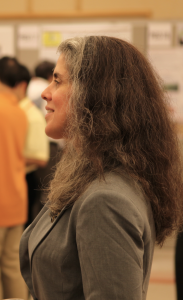 View my CV
View my CV
Mary Anne Cummings
Muons, Inc.
Statement
My first job in physics was as a small parts machinist for an atomic physics group at University of Michigan. That got me interested in experimental physics and as an undergraduate worked a hyperon experiment at Fermilab.
My Ph.D. work was on a fixed target experiment at Fermilab. I was on Fermilab’s DZero experiment for my post-doctoral and research scientist experience. My specific responsibility and contribution to this collider experiment was primarily on b production, and multi-jet analysis, including the top quark “all jets” channel – an analysis that was at time regarded as not possible to accomplish at DZero. Jointly with Norm Amos, the analysis was successful through our development of neural network analysis tools.
As a research professor at Northern Illinois University, I worked on the early design of the Auger Cosmic Ray and designed and proposed a radio-coherence experiment at Fermilab (for South pole High Energy neutrino physics program). Later at NIU, my research was funded through the Illinois Consortium for Accelerator Research (ICAR) specifically on muon cooling technology. Recently I was at NIU as a visiting research professor teaching graduate and undergraduate courses and working on characterization of nonlinear beams, particularly muon cooling channels; that program was cut short by the P5 recommendations that killed the muon collider program.
Most of my career has been Fermilab-centered, and I wish to be part of Fermilab’s program for the foreseeable future. I’m currently COO of a private SBIR research company, Muons, Inc., originally involved in Muon Collider and Neutrino Factory related projects. There is a very strong case to be made inventions of this company, particularly the high-pressure RF cavity and Helical Cooling Channel design, had revived interest in muon collider R & D, and for a while put bright muon beams front and center of Fermilab’s future intensity and energy frontier plans. We are also working on a design of an accelerator-driven subcritical molten salt reactor and are developing magnetrons to replace klystrons for future colliders.
Times change. It is no secret that I was disappointed in the muon collider recommendations of the old P5 Report, which I thought then and now were foolish and short-sighted. It appears that there has been a change of heart as the recent Snowmass meeting has revived muon collider possibilities. I’d love to encourage that.
I continue to believe that Fermilab is one of the country’s most underutilized science labs, and notwithstanding the challenging political and budgetary climate, there has been a lack of vision in our leadership and a tendency to retreat into safety of what they think the Dept. of Energy wants to hear. Many people feel that this passivity has not served our national program well, and they will have my attention. on the UEC.


